It’s a quiet Thursday morning in the ancient Spanish city of Toledo, and Mariano Zamorano is standing outside of his store looking out across the empty cobblestone street. Behind him, past walls covered with gleaming swords of varying lengths and designs, the faint sound of clanking metal can be heard.
The 67-year-old is the owner of the Mariano Zamorano Sword Factory, a shop that has survived for five generations. Unlike the owners of these mass-produced swords, Mariano is one of the last remaining original craftsmen of the notorious Toledo blade.
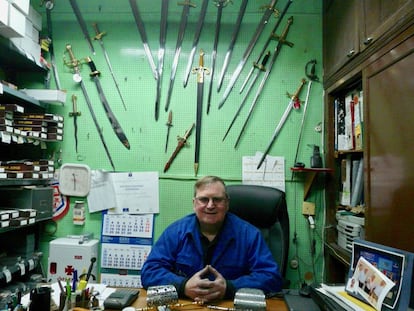
It’s a craft he’s learned from his father, also Mariano, who learned it from his father, another Mariano. But today the art has all but disappeared and the Zamorano family tradition is at risk of disappearing too.
Mariano’s son – a 40-year-old aeronautical engineer also called Mariano – is not interested in sword-making. “He doesn’t want swords … He hasn’t liked [them] since he was young. You can’t force someone to do something they don’t like,” says Mariano in his office, where dozens of swords hang from the walls and form piles on the shelves around him. “I have a grandson, but he’s only six years old so I don’t think there’s enough time,” he says with a laugh.
All European armies knew about the superior quality of Toledo steel
Richard Cohen, author
But Mariano is not just concerned about the future of the family business. “What worries me is that I am really becoming the last artisan in the city,” he explains.
Mariano is one of the few people who still know how to make a Toledo blade, which is made from “Toledo steel,” an alloy of iron and two kinds of steel with different carbon content, meaning it is both hard and flexible. Making one of these swords involves multiple steps and can take up to 50 hours.
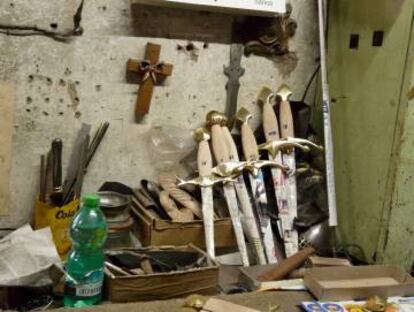
The result is a sturdy, superior quality sword apt for heavily armored armies, says Richard Cohen, the author of the sword-fighting history book By the Sword. According to Cohen, during the Second Punic War (218 BC to 202 BC), the Carthaginian General Hannibal Barca used the Toledo blade to defeat the Romans, who at the time were using inferior bronze swords.
The Romans later adopted the Toledo sword as they spread into the Iberian peninsula. “All European armies knew about the superior quality of Toledo steel. In other parts of the world, craftsmen have tried to imitate the Toledo product, but they all failed,” says Cohen in an email.
The sword became particularly important in the 16th and 17th centuries when Spain was a global power and Toledo one its most-prized imperial cities.
But by the end of the 18th century, the importance of Toledo and its famed weapon began to dwindle. “Given the rise of munitions in war, [the sword] was mainly used for ceremonial purposes,” explains Richard Kagan, professor emeritus of history at Johns Hopkins University.
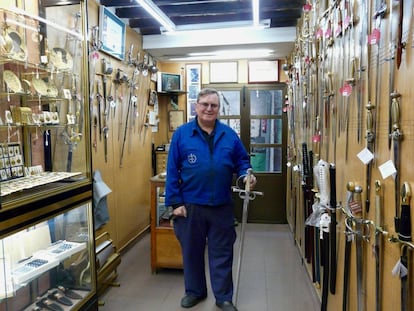
Blacksmiths were no longer sought after to forge blades made from Toledo steel, and slowly the art was lost. “I do not have the impression that, marzipan apart, there is much artisanal culture [left] in Toledo today,” says Kagan.
A fading tradition
Nowadays Toledo resembles something of a medieval playground. Commercial shops have capitalized on the city’s rich history, selling medieval trinkets and sword replicas from series and movies such as Lord of the Rings and Game of Thrones.
“The difficulties that artisans face is recognition,” says Mariano, who says there used to be an artisan school in Toledo that taught the city’s ancient crafts, including sword making, but it was shut down years ago because there weren’t enough students.
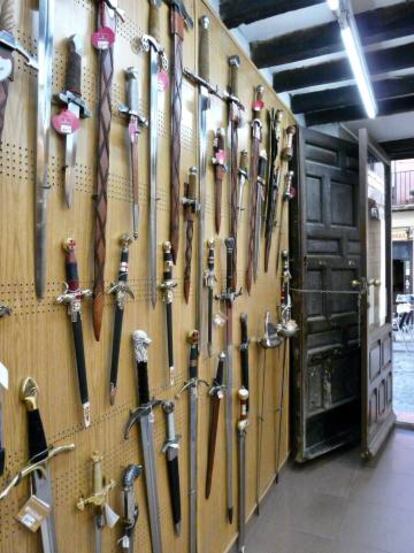
One of the biggest threats facing the survival of the craft is the boom in commercial shops that are eclipsing the artisans’ work. Not only do these stores flood the city with cheap, mass-produced swords, some also try to control the market by telling customers that authentic Toledo swords no longer exist, says Mariano. “This is truly evil. The difficulty artisans face is convincing these shops to tell the truth,” he adds.
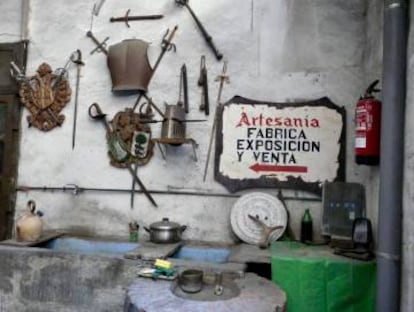
A real Toledo sword will be perfectly balanced, and its blade will be marked by small blemishes that show where the mallet struck it with varying degrees of strength, explains Mariano, as he runs his hands along one of his swords. His fingers, which are tinged a metallic gray, point out the blade’s small imperfections. A fake sword is completely smooth because it is shaped by a machine, which can regulate the strength of its strikes.
While Mariano also sells a few mass-produced swords and other souvenirs to stay afloat, his main business is the authentic Toledan blades, which attract people from all over the world. “Anyone can go buy a sword online, but getting one hand made in Toledo by an artisan, by a person who actually knows what they’re doing is insane,” says Drew Borgerding, 20, from Minnesota as he takes a tour of the sword factory.
But Mariano’s renowned store, like the craft itself, face an uncertain future. He is currently training three artisans how to make the Toledo sword in the hope that they will keep the tradition alive after he retires – which is not likely to happen anytime soon. “I will continue working until my body gives out,” says Mariano. “I have to recognize that my body doesn’t work like it used to when I was 50. But [the work] is another way of staying active. If I don’t go to work, I take a stroll. But I get bored, so I come and work.”
After all, for Mariano making swords is more than a job, it’s a passion; a tradition that thanks to him, has not disappeared. Yet.
How to make a Toledo sword
Because Toledo swords are only used today for ceremonial purposes and no longer require the strength of Toledo steel, Mariano makes the blades with carbon steel, which is a mix of carbon and iron. The sheets of steel are first cut from rods and heated up in the forge, which is an open flame in a 20-centimeter-wide stone pit filled with coal. When the metal gets very hot, it is removed and placed in a machine that repeatedly strikes and lengthens it. The blade is then returned to the forge, where it must turn a bright yellow color before it is removed again. Mariano knows when the blade needs to be cooled and tempered based on the color, a skill that has been passed down through the family.
Once the blade cools, it is dipped into oil, then slowly polished so that the color of the metal can be seen in the forge. As the forge is too small for the entire length of the blade, it has to be repeatedly run back and forth over the flame to ensure that the metal heats up evenly. When it turns a light yellow, the color of hay, it is put into water to cool. This makes the sword malleable enough to be shaped, by using a mallet against an anvil. The blade then passes onto the workshop where a wooden hilt is fashioned onto it.
Depending on the model, a blade can take up to 40 or 50 hours to complete, and five hours alone are usually needed to make the pommel. Prices vary depending on the amount of time and effort put into the swords, but some can cost thousands of euros. Customers are able to commission specific blades by sending in designs and models, but not all those requested are able to be made. “There are some swords that are impossible to make. They”re generally ones from movies and shows [like Game of Thrones]. To make some things into iron would cost a lot of money and would lead to a fragile sword. So I always say that the swords from movies, which are very pretty, are good for the movies because they”re made of plastic,” says Mariano.
